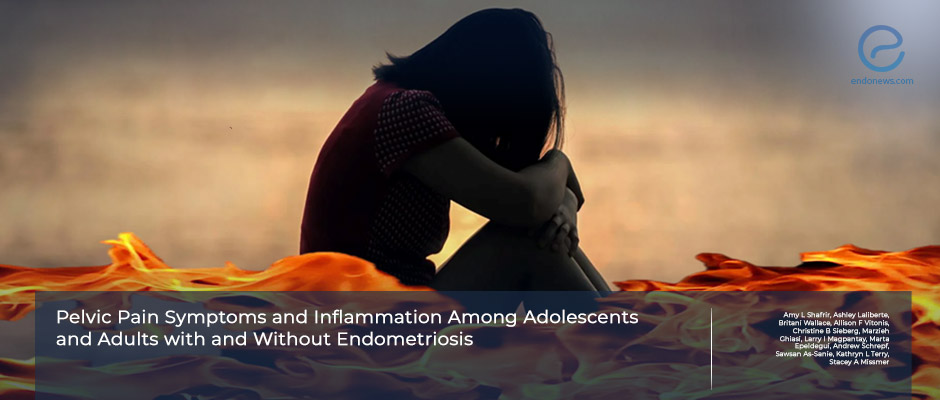Inflammation, Analgesic Use, and Pelvic Pain: Evidence From Women With and Without Endometriosis
Sep 3, 2025
Pelvic pain–inflammation link depends on disease type and pain management
Key Points
Highlights:
- Pelvic pain and systemic inflammation are linked, but the relationship differs in women with vs. without endometriosis:
- In women without endometriosis, certain inflammatory markers were linked with pain during intercourse and pain with bowel movements.
- But, in women with endometriosis, the association between inflammatory markers and pain was inconsistent and appeared to be influenced by painkiller use.
Importance:
- The results of the study underscore the complexity of the inflammation–pelvic pain relationship, suggesting that both disease status and medication use shape the biology of pain.
What’s done here:
- This crossectional study analyzed inflammatory markers in 389 women with surgically confirmed endometriosis and 505 controls from the Women’s Health Study: From Adolescence to Adulthood (A2A).
- Circulating cytokines and chemokines (including IL-8, IL-6, IL-10, TNF-α, MCP-1, MCP-4, IP-10) were measured with multiplex assays.
- Pain phenotypes (dysmenorrhea, acyclic pelvic pain, dyspareunia, pain with bowel movements) were assessed using standardized tools.
Key results:
- The levels of IL-8 and MCP-4 were lower in women without endometriosis reporting dyspareunia; lower IL-8, MCP-1, and IP-10 were found in those with pain during bowel movements.
- IN Endometriosis cases, there was NO consistent associations overall. However, analgesic use modified the results:
- Cases using analgesics had lower IL-8 with acyclic pelvic pain.
- Cases not using analgesics had higher MCP-4 with bowel pain.
- The predominance of peritoneal superficial lesions in the cohort may explain the weaker inflammation–pain link in endometriosis compared to controls.
Strengths and Limitations:
- Large, well-characterized cohort including many adolescents and young adults; rigorous biomarker assays with cross-platform recalibration, and careful phenotyping of pelvic pain using validated measures are the strengths of the study.
- Limitations are, cross-sectional design that prevents causal conclusions; few participants with deep endometriosis, limiting applicability to inflammatory subtypes. Also Some cytokines showed variability in reproducibility; associations may partly reflect chance; and undiagnosed endometriosis in the control group cannot be excluded.
From the Editor-in-Chief – EndoNews
"This study reminds us that the biology of pelvic pain is anything but straightforward. While inflammation is often assumed to be the central culprit, these findings reveal a more nuanced reality: the links between cytokines and pain differ sharply depending on whether women have endometriosis, and whether they use analgesics.
For clinicians, this is a warning against oversimplification. Pain cannot be reduced to a single biomarker or pathway—context matters. Disease subtype, medication use, and even lesion depth all shape the inflammatory signature of pelvic pain. For researchers, the message is equally clear: future work must dissect these variables rather than lumping all pain under one umbrella.
Ultimately, this paper underscores a crucial shift: inflammation and pain are connected, but the connection is conditional, dynamic, and still poorly understood. Only by embracing this complexity will we move toward meaningful biomarkers and precision treatments for women’s pain."
Lay Summary
Pain during intercourse and pain with bowel movements are associated with inflammatory markers in women without endometriosis, found a new study published in the International Journal of Molecular Sciences.
On the other hand, the link between symptoms of pelvic pain and inflammatory markers in women with endometriosis differed based on the use of painkillers.
“The complex relationship between inflammation and pelvic pain, including among those without a diagnosis of endometriosis, warrants further research,” the authors of the study said.
The team led by Dr. Stacey A. Missmer analyzed markers of inflammation in 389 women with surgically confirmed endometriosis and 505 women without the disease in the Women's Health Study: From Adolescence to Adulthood (A2A).
All participants had reported period pain, pelvic pain not associated with periods, pain during intercourse, and pain with bowel movements.
The researchers measured the levels of interleukin (IL)-1β, IL-6, IL-8, IL-10, IL-16, tumor necrosis factor (TNF)-α, monocyte chemotactic protein (MCP)-1, MCP-4, thymus and activation-regulated chemokine (TARC), and interferon gamma-induced protein (IP)-10 in the serum of all the participants.
Then, using multivariate linear regression analysis, they computed biomarker-level geometric means for each symptom.
The results showed that women without endometriosis who experienced pain during intercourse had lower levels of IL-8.
The levels of the cytokine were also lower in women without the disease who experience pain with bowel movements.
There were no significant associations between pelvic pain and markers of inflammation in women with endometriosis.
However, the association between the levels of inflammatory markers and pain varied based on the use of painkillers in women with the disease.
Research Source: https://pubmed.ncbi.nlm.nih.gov/40508188/
pain during intercourse pain with bowel movement inflammation pelvic pain

